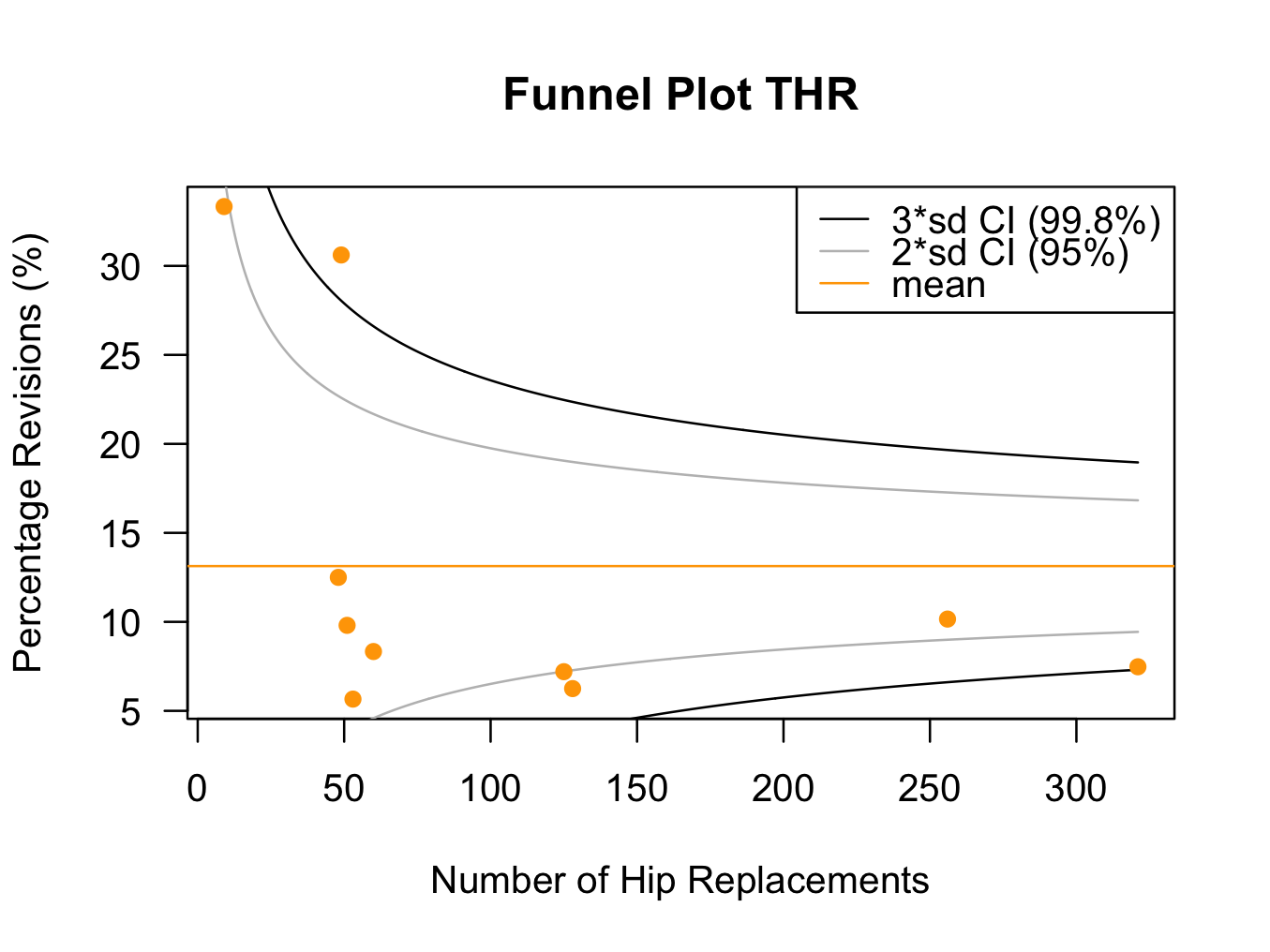There are two types of funnel plot used in the scientific literature. One is used to check for the presence of publication bias in a meta-analysis. The other is used to compare institutional performance.
Funnelplot to check for publication bias 1:
Download the plottranexamic.rda dataset for this example 2
http://www.bmj.com/content/344/bmj.e3054 3
The data frame is called tranexamic and contains the details of 87 studies included in the meta-analysis. The data can be seen by entering:
tranexamic
(output omitted for brevity)
The variables are: Trial (authors and date of the trial), TxE (number of events in the treatment group), TxN (number of observations in the treatment group), ControlE (number of events in the control group) and ControlN (number of observations in the control group).
To create a funnel plot the package meta 4 should be installed. To perform meta-analysis, using the fixed and random effects models, showing the odds ratio:
library(meta)
metatranexamic<-metabin(TxE,TxN,ControlE,ControlN,data=tranexamic,sm=”OR”)
To show the details of the analysis:
metatranexamic
OR 95%-CI %W(fixed) %W(random)
1 0.1302 [0.0063; 2.6752] 0.34 0.29
2 0.8400 [0.3339; 2.1131] 1.00 1.65
–
–
87 0.7959 [0.4204; 1.5066] 2.15 2.19
Number of studies combined: k=87
OR 95%-CI z p-value
Fixed effect model 0.4113 [0.3679; 0.4597] -15.6358 < 0.0001
Random effects model 0.4009 [0.3379; 0.4757] -10.4732 < 0.0001
Quantifying heterogeneity:
tau^2 = 0.2411; H = 1.33 [1.17; 1.51]; I^2 = 43.6% [27.2%; 56.4%]
Test of heterogeneity:
Q d.f. p-value
152.57 86 < 0.0001
Details on meta-analytical method:
– Mantel-Haenszel method
– DerSimonian-Laird estimator for tau^2
– Continuity correction of 0.5 in studies with zero cell frequencies
Both, the fixed and random effects model show a significantly different odds ratio (p<0/0001). When different studies show different results, this can be due to chance (study homogeneity) or genuine differences (study heterogeneity). The value of I squared 5 shows moderate heterogeneity (44%) with a significant p value.
To show the funnel plot with an appropriate title:
funnel(metatranexamic)
title(main=’Meta Analysis Tranexamic Acid’)
 The plot shows an an overall odds ratio of approximately 0.5, favouring treatment with tranexamic acid.
The plot shows an an overall odds ratio of approximately 0.5, favouring treatment with tranexamic acid.
Please note that the vertical axis has a reverse scale, so the larger studies (with a smaller standard error) are on the top of the graph and the smaller studies are at the bottom of the graph. The odds ratio scale (horizontal) is logarithmic. An odds ratio of less than 1.0 indicates a positive (less bleeding) effect of tranexamic acid and an odds ratio larger than 1.0 suggests no effect. Without publication bias, the plot is pyramid shaped. A skewed plot indicates publication bias. In this plot, there are equal number of larger studies with a positive or negative effect. However, all smaller studies (lower part of the plot) show a positive effect (OR < 1) of tranexamic acid (there are no studies in the lower (right) part that have an odds ratio > 1.0). This indicates publication bias of smaller studies; only smaller studies that showed a positive effect of tranexamic acid were published.
Funnelplot to compare institutional performance 6;7:
A different type of funnel plot can be used to compare institutional or surgical performance. The National Joint Registry 8 has used these plots to show differences in standardised mortality rate between surgeons and institutions.
Download the plotfunnelhip.rda dataset for this example. To create this type of funnel plot, the package ‘berryFunctions’ 9 should be installed.
library(berryFunctions)
The data frame is called plotfunnelhip and has the variables: surgeon, cases (number of cases) and revisions (number of revisions). To show the data frame:
plotfunnelhip
surgeon cases revisions
1 1 49 15
2 2 9 3
3 3 128 8
4 4 53 3
5 5 321 24
6 6 256 26
7 7 125 9
8 8 51 5
9 9 48 6
10 10 60 5
To create the funnel plot:
funnelPlot(plotfunnelhip$revisions,plotfunnelhip$cases,xlab=’Number of Hip Replacements’,ylab=’Percentage Revisions (%)’,main=’Funnel Plot THR’)
The code can be copied and pasted into the console, but the quotation marks may need to be re-entered.
 The horizontal orange line indicates the mean number of revisions (13%). The ‘funnel’ is created by the confidence intervals as indicated. The more procedures a surgeon does, the smaller the standard error (and the narrower the funnel).
The horizontal orange line indicates the mean number of revisions (13%). The ‘funnel’ is created by the confidence intervals as indicated. The more procedures a surgeon does, the smaller the standard error (and the narrower the funnel).
In this plot, most (8) surgeons are below the mean. However, two surgeons are well above the mean; one almost two standard deviations and one more than three standard deviations. There may well be a very valid reason why one surgeon has a revision rate more than three standard deviations above the mean, but this would require further evaluation.
To find the mean:
percentage<-100*plotfunnelhip$revisions/plotfunnelhip$cases
mean(percentage)
[1] 13.13261